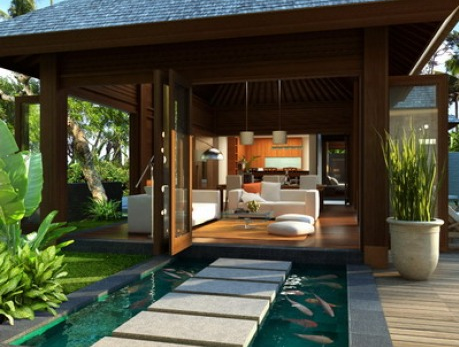A House designer on holiday:

This blog post is a poor attempt to justifying my recent holiday to Bali as a business trip. It’s true that most of my photos when I go on holiday are generally business or at least building design related -clever details, materials and weird angles of buildings and foreign objects rather than picturesque scenery or images of me posing beside a landmark with a selfie stick giving the peace sign, it is a big stretch to say my holiday was for business though more like to get away from running my own business.
I’ve forever cringed when I’ve heard people describe their “Bali inspired” pool areas or Instagram posts containing the hash tag #balivillalifestyle #infinitypoolsfordays both real hashtags tagged by 183 bogans) but since visiting this place myself my views have changed somewhat, there are still a million flagrant crimes against architecture and humanity also the term ‘featurism’ would be a staggering understatement at times in regards to the over the top bling on top of bling buildings but there are many small lessons to be gleaned here, for instance the importance of outdoor Iiving space, the infinite beauty of a well designed infinity pool, indoor /outdoor bathrooms open to the elements, dry gardens and small internal courtyards, verandah lofts and clever built in seating, balustrades on verandas that are both seats, bench tops and back rests etc.
It is rare to see a pool fence in Indonesia same with balustrades or handrail that would comply to even the most basic Australian laws but this to me is a foreign beauty, in Australia we live in a nanny state of often draconian laws which at best should be voluntary, if you have no kids why is it mandatory for a pool fence? especially when this pool is directly adjacent to a larger body of water such as a dam or river, the same is true for balustrading requirements in Australia to any deck over one meter high we are forced to build a 1m minimum balustrade with no more than a 125 mm gaps (I am not saying don’t put any kind of safety rail around dangerous drop offs but making a mandatory gap size just leads to restrictions in design and creates a boring uniformity.
The use of timber and concrete in Bali is prolific -not a steel structure to be seen for days, there is far too much embellishment of objects and materials here for my liking though ;carvings and filigree elements, pseudo-traditional motifs that take away from the simplicity and techne of the talented Javanese carpenters. I am told most of the really intricate timber work over here is outsourced to the Javanese as timber work is supposedly ingrained in their culture.
Reinterpreting balinese housing design in a non-bogan way on the sunshine coast.
It’s only truly on wet days that you can appreciate a good living space, when it’s cold and miserable outside. Currently I’m in Indonesia writing this going mad with cabin fever I’ve run out of pirated DVD’s and I’m stranded in a remote little hut in the forest of Nusa Penida. Sadly there is basically no out door space aside from a one meter deep verandah all of the windows are fixed panel glass so that doesn’t really help relieve things either. I realise it’s a perfect time to brainstorm about how to design structures in future to combat inevitable shitty weather. Firstly it’s important to have a decent sized enclosed area which keeps you dry and out of the rain, wind and ground water. TO BE CONTINUED-